eCommerce Marketing Case Study: How a 100+ Year Old Brand Adapted to the Digital Age
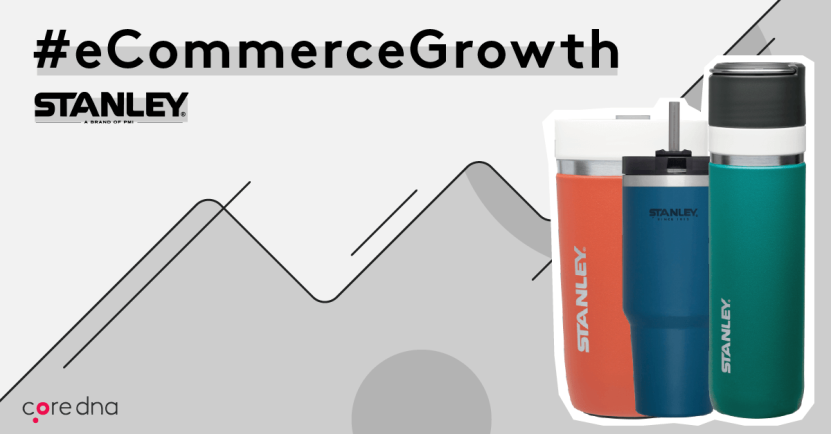
Do you remember your dad ever carrying a green, steel bottle on the way to work or a camping trip?
That’s a Stanley brand thermos. And they’re still as popular (if not more popular) today.
Stanley, a PMI brand loved by generations, has adapted their marketing efforts over the years to make a killing in the eCommerce space, raising awareness around the brand like never before.
They get hundreds of thousands of website visitors every month, bring in tons of traffic from search engine results pages (SERPs), and post consistent blog content. But that’s not all. The brand uses a detailed, tried and true strategy to keep bringing in new and returning customers online.
In this post, we’re going to dive into how Stanley approaches their eCommerce marketing strategy to dominate SERPs, maintain great customer relationships, and more.
But first, let's discuss exactly who Stanley-PMI is as a brand.
Who is Stanley-PMI?
Stanley-PMI offers an assortment of vacuum bottles, mugs, thermoses, cookware and more. And they’ve been around for over 100 years. The company was created by inventor William Stanley Jr., who invented the all-steel vacuum bottle in 1913. The vacuum insulation technology created by Stanley can keep beverages hot or cold for as long as 24 hours.

(Image Source)
From the time the Stanley brand was created, the Stanley bottle has evolved from a concept to an iconic staple used for workdays, camping, and more.

(Image Source)
Stanley has been backed by Pacific Marketing International (PMI), an organization that is committed to sustainability and environmental protection, since 2002. Back in 2006, PMI created eCycle®, making them the first ever company to create reusable and food-safe containers made with recycled materials.
Now, Stanley has over 170,000 website visitors each month.

They offer so much more than the original Stanley vacuum thermos. They also sell mugs, cups, coolers, cookware, and flasks.

Their products have evolved to not only help you keep your hot drinks hot and your cold drinks cold - but they can also be used to serve liquor or beer, cook dinner, or simply store your food.

Next, let’s take a look at how Stanley’s website has changed over the last few months.
How the Stanley-PMI site has changed
Site design can make or break your brand.
Stanley changed their site design several times in the course of a few months to improve CTAs, graphics, and overall design quality. Here’s a snapshot of the Stanley-PMI site in February 2017.
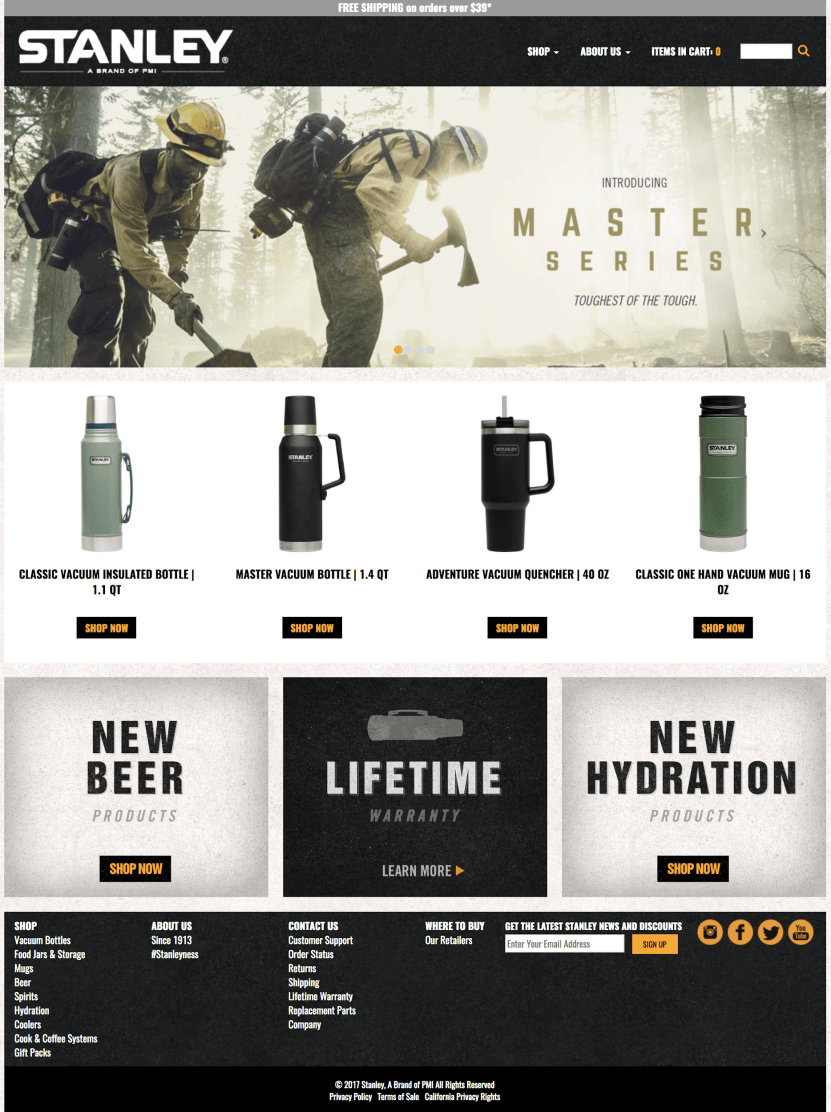
Now, here’s a look at Stanley-PMI’s site today.
After performing in-depth keyword research and creating buyer personas, Stanley-PMI built a silo for their main navigation menu optimized for SEO and the user intent.
Just look at the main navigation menu before.
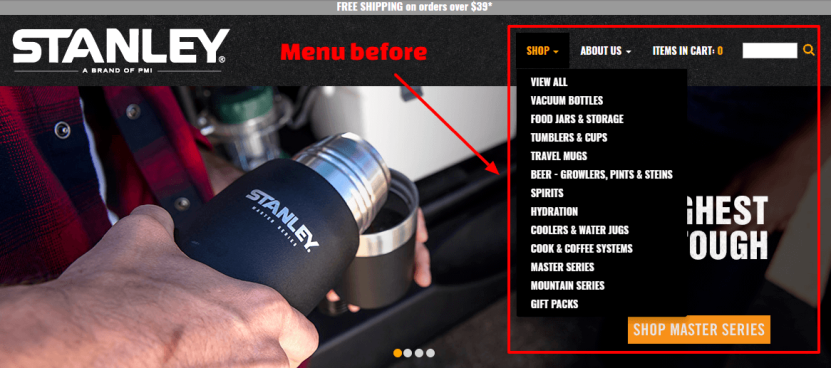
And, now after.
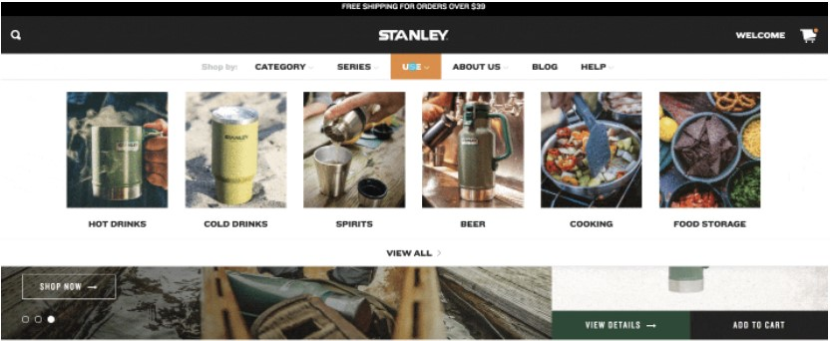
Visitors spend, on average, 23% of their attention on the navigation of your website. It’s what catches their attention. After investing, Stanley-PMI was able to create a header that engages visitors to stay and buy organized by category, series, and use.
And, that’s not the only big change.
They added product price, product features, reviews, and an actionable CTA of “Add to Cart” to their featured products section. Here’s a look at the before:
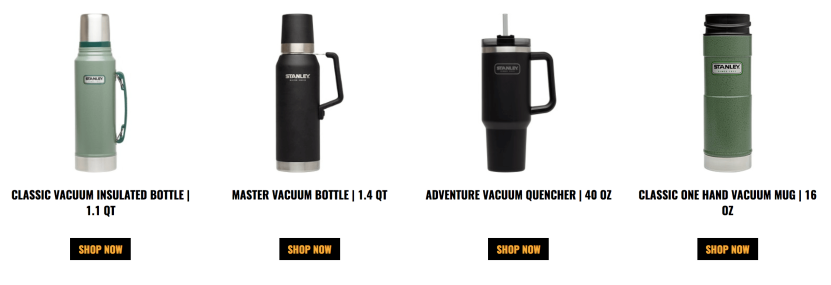
And, after:
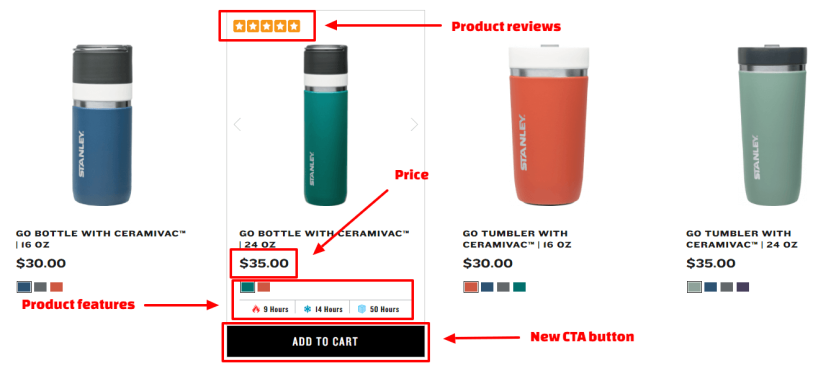
The simple swap from “Shop Now” to “Add to Cart” creates a clearer CTA that pushes the user to buy the product.
Plus, every product is now listed with the color options available, ratings, and a brief rundown of how long each item can keep consumables hot, cold, or frozen.
Shoppers can now filter products by color, series, material, features, contents, and ideal use.

And, you can see how Stanley-PMI started to incorporate their buyer personas and brand personality after the scroll on the homepage.
Previously, they listed products and warranty options.

Whereas now, they matched their series products with buyer personas of Classic, Master, and Adventure. Each of these appeals to a different lifestyle. Adventure lures the traveler while Master targets the blue collar worker.

Based on these buyer persona’s, Stanley-PMI also reworked their product pages attempting to address the pain points and lifestyles of each of their buyer personas.
Take a look at their previous product page for their Master Vacuum Bottle.

And, now, their product descriptions are tailored to the right audience.
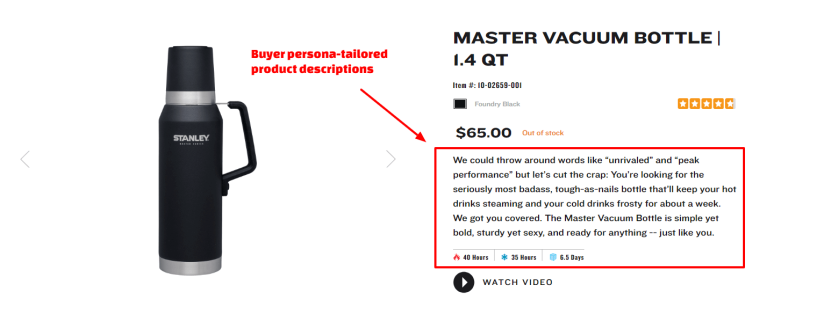
It’s even paired with a product video.
At checkout, users have to create an account with Stanley or log in, which helps them maintain relationships with current customers and add new ones to their subscriber list.
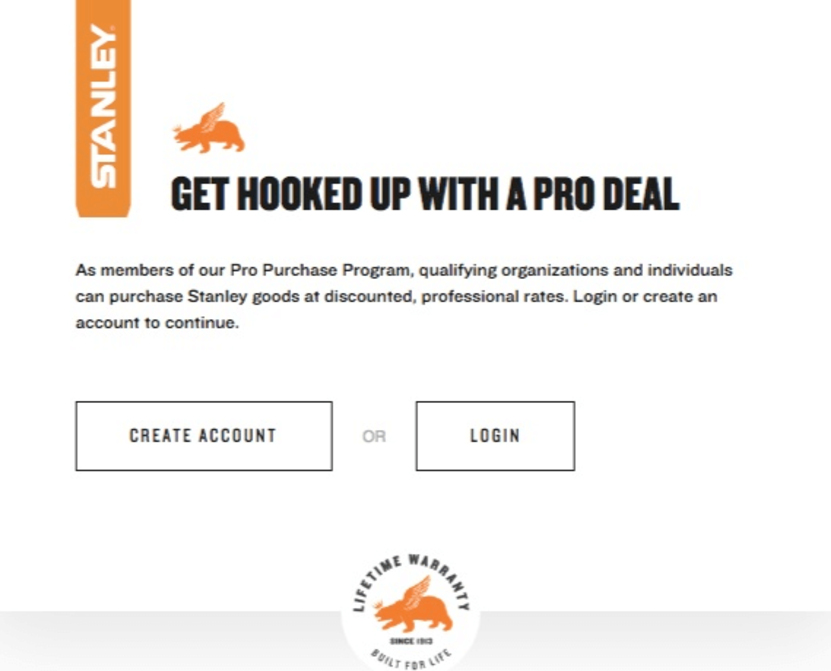
The revamps to their overall UX helped boost their conversion rate to 0.93% and reduce their bounce rate to 34.83%.
But, the overall UX isn’t the only big change Stanley-PMI has made. In mid-October, Stanley migrated to Core dna. That’s when their website began to really change.

Before migrating to Core dna, the company was averaging 10,000 pageviews per day. Now, they’re averaging 15,000 per day.
Traffic sources Stanley-PMI uses to drive targeted users
Stanley gets a lot of mobile traffic, especially from Facebook and search engines.
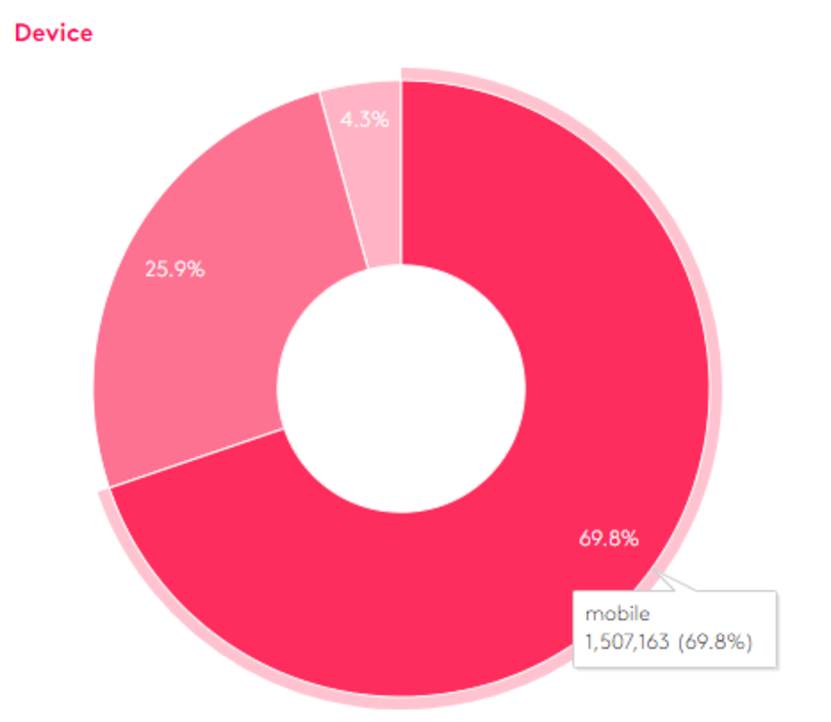
As the mobile-first index officially rolled out, we’re going to see more eCommerce businesses grow their mobile keyword strategy to match their desktop. You can find the same information for your site using Ahrefs.
For Stanley, 75.72% of all traffic comes from search, while 19.5% comes from direct sources, according to SimilarWeb.

And it’s clear their marketing team implemented an SEO-focused strategy (which clearly works). Just look at the jump in backlinks over the past few months. They moved from 901 backlinks to over 1,200 from May 2017 to May 2018.
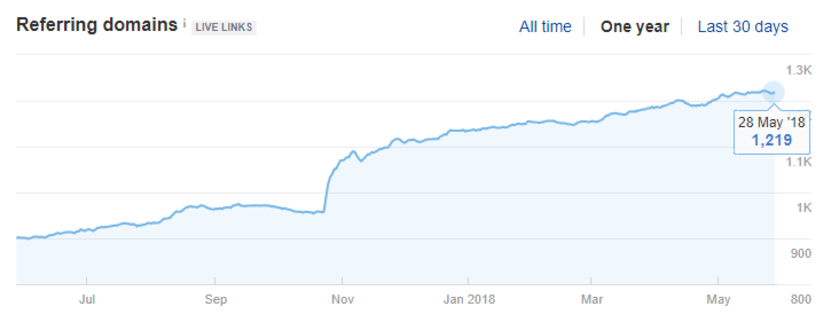
And, the quality of links have improved. Stanley-PMI is now seen on major sites like Martha Stewart.
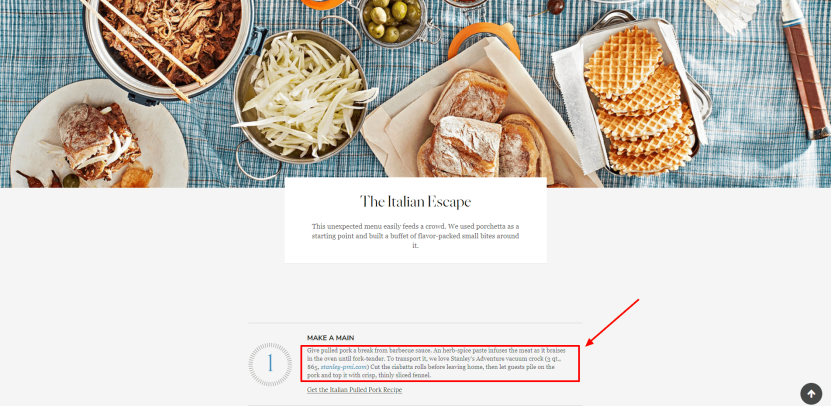
(Image Source)
And, Outside Magazine.
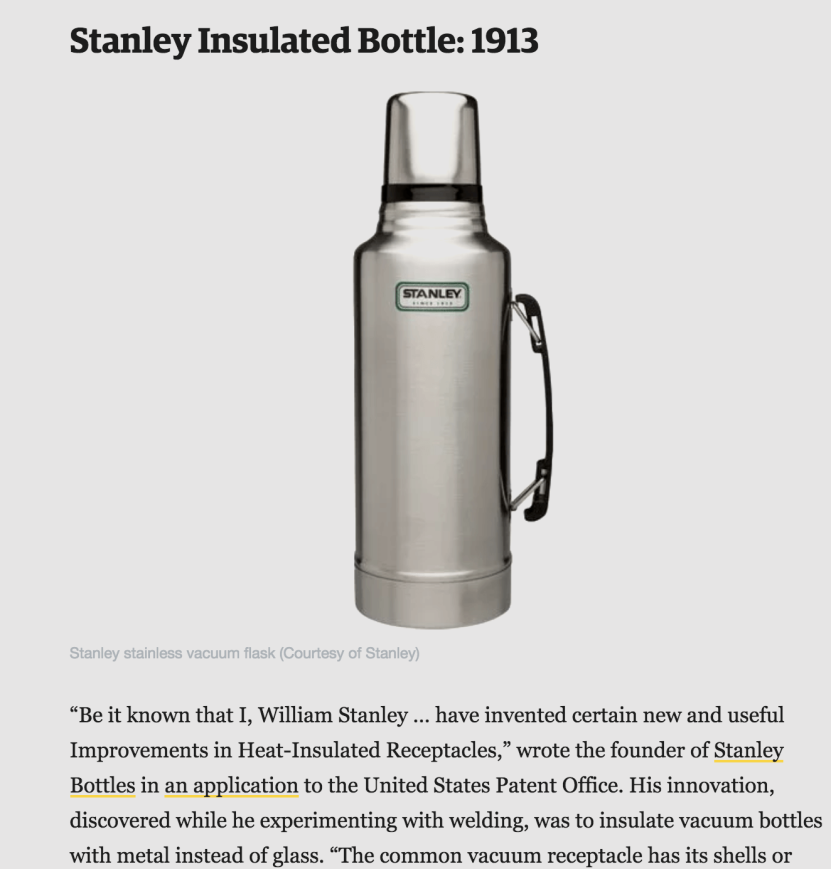
And, they even partnered with Starbucks and are now featured in Real Simple.
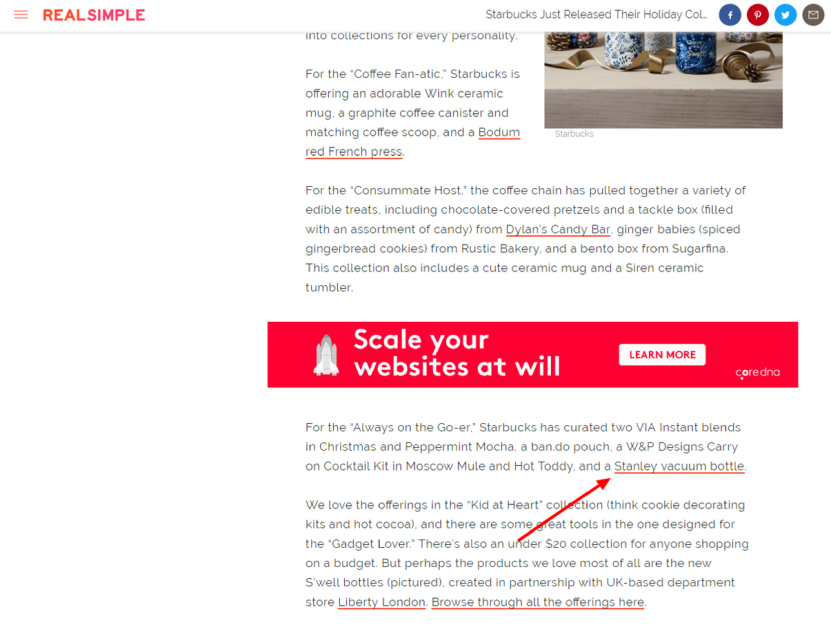
(Image Source)
To top it off, Stanley is receiving multiple links from major domains. Men’s Health alone links to Stanley 17 times.
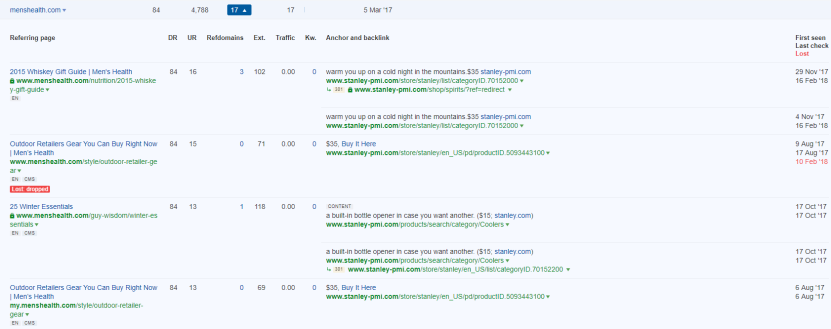
The best part is that they aren’t implementing any tactics that you can’t use.
How Stanley-PMI’s valuable blog content fuels SEO
Every brand should have a blog.
Why? Because blogs fuel SEO. Search engines recognize valuable content and give it the love it deserves. And so do readers. You’ll prove your credibility by creating meaningful blog posts that help to improve your customers’ lives or teach them something new.
It’s best to blog several times per month for best results since 22.7% of bloggers are already doing it, according to Orbit Media.
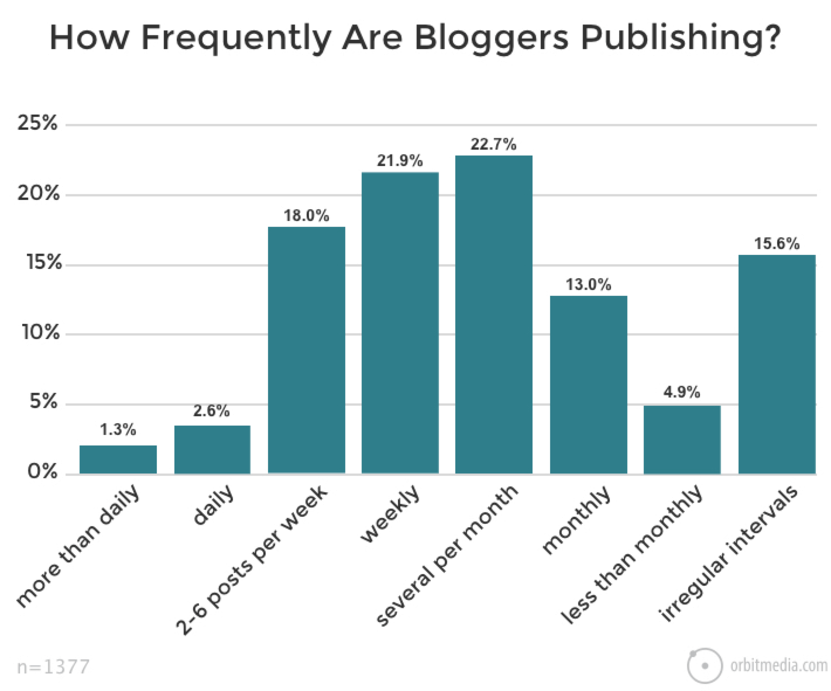
You can come up with blog ideas by looking at your competitors’ top performing content and writing something that expands on the same type of topic.
According to BuzzSumo, here are some of Stanley’s top-performing blog posts:
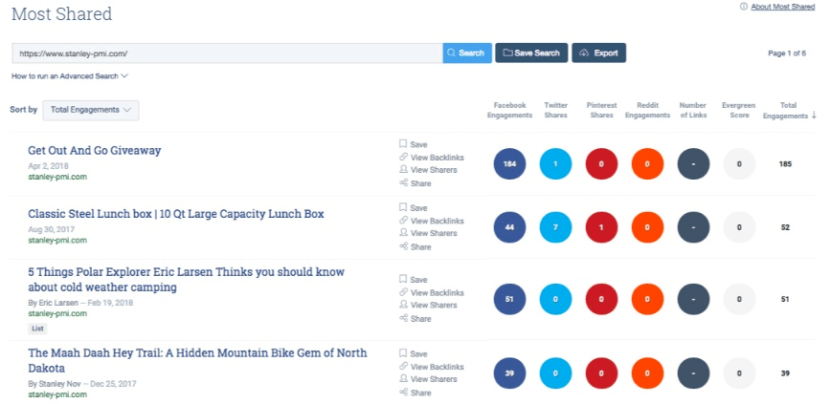
This blog post on Steelhead Fishing The Pacific Northwest was written by Jayson Hale. He’s an Olympic snowboarder, geologist, and photographer.
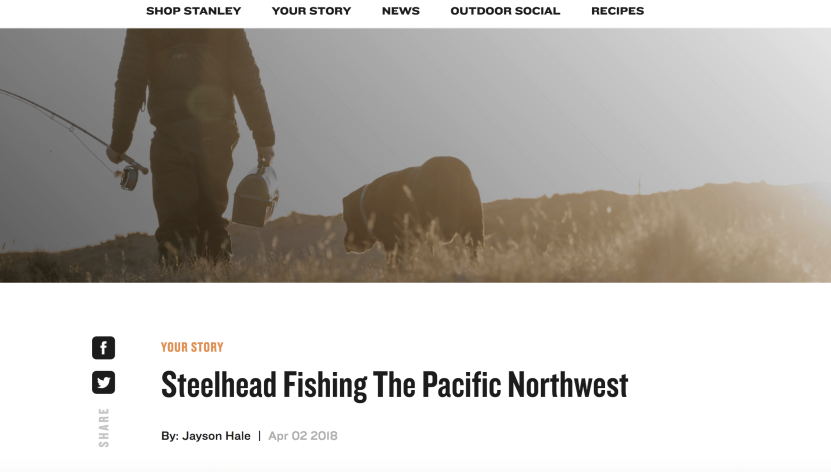
This post is one of the top-engaged pages on Stanley, receiving 52 engagements since being published in April.
Why?
Because this blog post was written Jayson Hale, who is also an influencer on social media. He’s got almost 10k Instagram followers and has worked with brands like Patagonia and Backcountry.

Furthermore, the blog post titled, “5 Things Polar Explorer Eric Larsen Thinks You Should Know About Cold Weather Camping” was written by Eric Larsen.

Eric Larsen is the first person to go to the South Pole, North Pole, and the top of Mt. Everest in one year. He also has 23k Instagram followers, 10.4k Twitter followers, and over 40,000 Facebook Fans.
By partnering with key influencers related to Stanley’s buyer personas, they are able to achieve higher engagements on blog posts like these above.
But, Stanley also writes blog posts on topics ranging from evergreen topics like “Tips For Planning An Epic Outdoor Adventure With Friends” to a product-specific article like ”Old Stanley VS New Stanley: What’s Really Changed In The Unbreakable Bottle?”
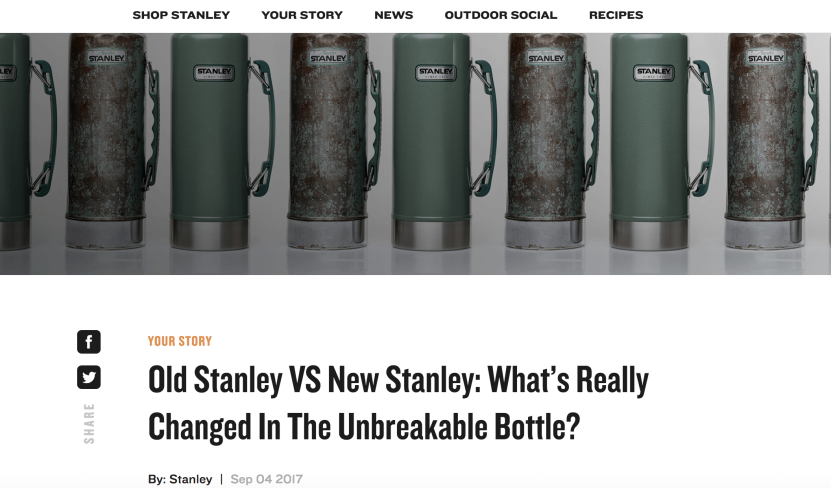
If you want to try something similar with your own blog to gain backlinks, start building content that’s link-worthy like Stanley. If you’re looking for a tool that can help you brainstorm some topics, try out AnswerThePublic for ideas.
Why Stanley’s social media strategy is crushing the competition
Social media marketing has become a necessity if you want to stay on top in your industry.
Most marketers spend at least one to five hours per week on social media marketing, according to Statista.
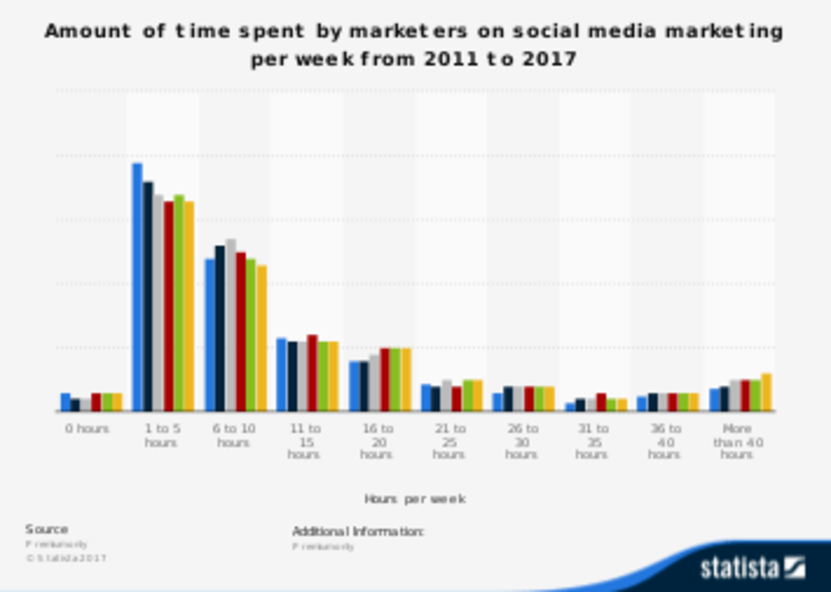
Stanley is active on several social platforms, but the social account that brings in the most traffic for the brand is YouTube.
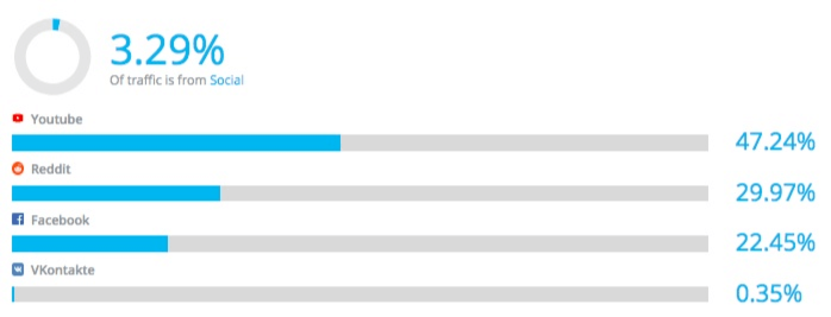
The company has racked up over 400,000 video views on their channel.
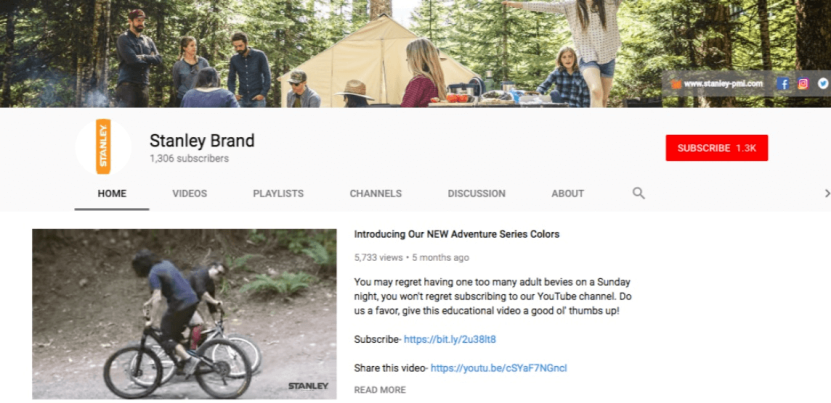
They run several different kinds of series, like Stanley Boozy Favorites, where they share cocktail recipes with viewers.

On Facebook, the Stanley page has racked up over 170,000 likes.
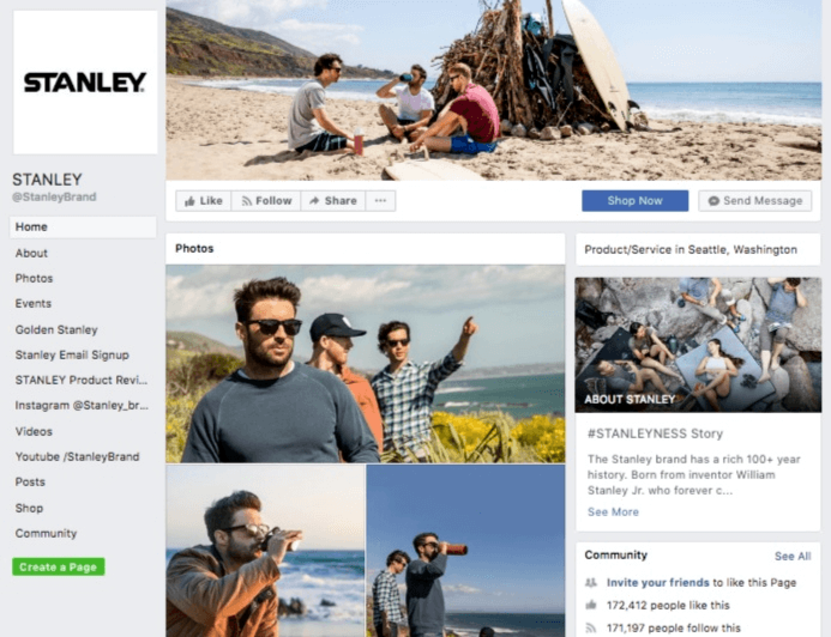
On Twitter, the brand shares giveaways, product posts, and user-generated content with their followers.

On Reddit, people rave about their Stanley products.

The company is also active on Instagram, where they have a following of 57,000 people.

Stanley is also using brand ambassadors to spread the word about their products on social media.

This isn’t a surprise since 51% of marketers believe they can acquire better customers through influencer marketing.

You can find influencers and brand ambassadors to work with your team, too. Write them a direct message and tell them that you want to get in touch.
The worst that they can say is no.
Like Stanley, try to be as active as possible on as many different platforms as possible for the widest reach. Post some branded YouTube videos and create a recurring video series. Run targeted ads on Facebook and post regularly to capture as many followers as possible.
Host giveaways or share live video to boost engagement and reach. Live video on Facebook directly correlates with an increase in views, likes, and shares.
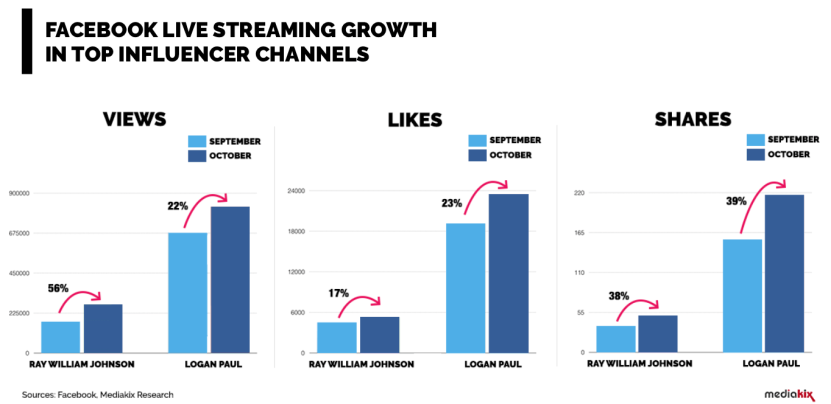
On Twitter, run a few contests or re-post user-generated content. You could even craft a few promoted tweets, like this one from Blue Apron.
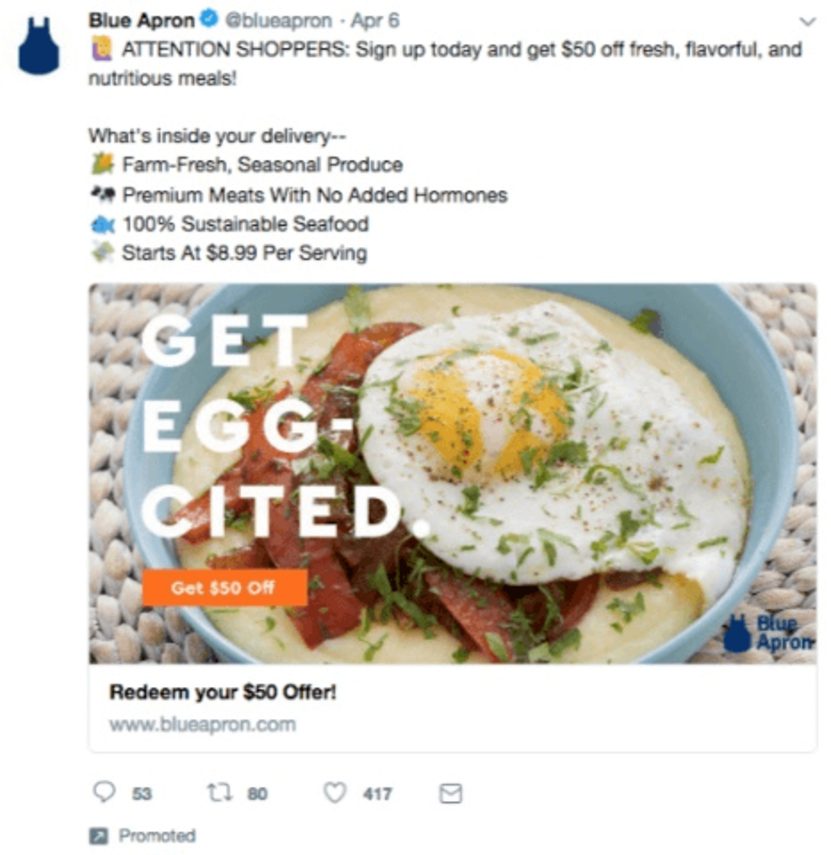
Conclusion
The Stanley brand is as iconic today as it was 100 years ago. Almost everyone recognizes and remembers their steel vacuum thermos bottles. And Stanley is making a killing in the eCommerce game by adapting their marketing efforts in line with consumer and technology trends.
They experiment with web design often and switch up elements to find out what works best on their site. Their traffic comes primarily from SERPs, but they’ve also built up tons of credible backlinks through a regular blogging strategy. That same blog content builds trust, established the brand as a thought leader and boosts their placements on Google naturally. Finally, Stanley are active on almost every major social media platform, posting quality content that engages their followers.
Follow a similar marketing strategy, and you could become just as iconic as Stanley.
Which tactic used by Stanley are you going to try out on your eCommerce site first?













